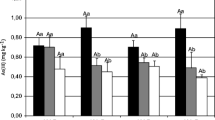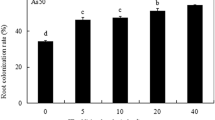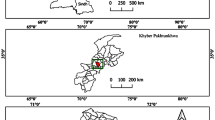Abstract
Effects of arbuscular mycorrhiza (AM) and phosphorus (P) application on arsenic (As) toxicity were studied in a rhizobox system with As-contaminated soil collected from Shimane Prefecture, Japan. The treatments consisted of a combination of two levels of AM (Glomus aggregatum) inoculation (−AM and +AM) and two levels of P application (−P and +P at 30 mg P kg−1). Sunflower (Helianthus annuus L.) seedlings were cultured in rhizoboxes for 6 weeks. Rates of root AM infection in +AM treatments were about 40% regardless of P application. AM inoculation as well as P application reduced As toxicity symptoms, most clearly so in the +AM−P treatment. Plant growth was highest in the +AM + P treatment. Shoot As concentrations were slightly reduced by AM inoculation but enhanced by P application. Shoot P concentration in the +AM−P treatment was similar to that of +P treatments and was higher than in −AM−P. Analyses of rhizosphere soils at the end of the cultivation period indicated that P application increased water-soluble As (WS−As) in all compartments while AM inoculation increased WS−As in the central compartment only. Both the WS−arsenite [WS−As(III)] and the dominant form, arsenate [WS−As(V)], showed gradients toward the root surface. Dimethylarsine (DMAA) was detected in the +AM treatments only. To our knowledge, this is the first report of the occurrence of DMAA in the mycorrhizosphere. AM inoculation increased WS−P similarly as +P treatments did and promoted acid phosphatase activity in the soil. In conclusion, AM inoculation alleviated the effects of As toxicity by improving P nutrition without increasing As concentrations in the shoots. Moreover, AM appeared to be involved in the transformation of soil inorganic As into less toxic organic forms.
Similar content being viewed by others
References
Abedin MJ, Cotter-Howells J, Meharg AA (2002) Arsenic uptake and accumulation in rice (Oryza sativa L.) irrigated with contaminated water. Plant Soil 240:311–319
Alef K, Nannipieri P, Trazar-Cepeda C (1995) Phosphatase activity. In: Alef K, Nannipieri P (eds) Methods in applied soil microbiology and biochemistry. Academic Press, London, pp. 335–344
Asher CJ, Reay PF (1979) Arsenic uptake by barley Hordeum vulgare cultivar zephyr seedlings. Aust J Plant Physiol 6:459–466
Bentley R, Chasteen TG (2002) Microbial methylation of metalloids: arsenic, antimony and bismuth. Microbiol Mol Biol Rev 66:250–271
Bray RH, Kurtz LT (1945) Determination of total, organic and available forms of phosphorus in soils. Soil Sci 59:39–45
Brundrett M, Melville L, Peterson L (1994) Practical methods in mycorrhiza research. Mycologue Publications, Guelph, Canada 161 pp
Caille N, Swanwick S, Zhao FJ, McGrath SP (2004) Arsenic hyperaccumulation by Pteris vittata from arsenic contaminated soils and the effect of liming and phosphate fertilization. Environ Pollut 132:113–120
Cao X, Ma LQ, Shiralipoun A (2003) Effect of compost and phosphate amendments on arsenic mobility in soils and arsenic uptake by hyperaccumulator P. vittata L. Environ Pollut 126:157–167
Esteban E, Carpena RO, Meharg AA (2003) High-affinity phosphate/arsenate transport in white lupin (Lupinus albus) is relatively insensitive to phosphate status. New Phytol 158:165–173
Fitz WJ, Wenzel WW (2002) Arsenic transformation in the soil–rhizosphere–plant system: fundamentals and potential application to phytoremediation. J Biotech 99:259–278
Frankenberger WT, Arshad M (2002) Volatilization of arsenic. In: Frankenberger WT (ed) Environmental chemistry of arsenic. Marcel Dekker Inc., New York, pp. 363–380
Gadd GM (2004) Microbial influence on metal mobility and application for bioremediation. Geoderma 122:109–199
Giovannetti M, Mosse B (1980) An evaluation of techniques for measuring vesicular arbuscular infection in roots. New Phytol 84:489–500
Goldberg S (2002) Competitive adsorption of arsenate and arsenite on oxides and clay minerals. Soil Sci Soc Am J 66:413–421
Gonzalez-Chavez C, Harris PJ, Dodd J, Meharg AA (2002) Arbuscular mycorrhizal fungi confer enhanced arsenate resistance on Holcus lanatus. New Phytol 155:163–171
Gulz PA, Gupta S, Schulin R (2005) Arsenic accumulation of common plants from contaminated soils. Plant Soil 272:337–347
Holmgren GGS (1967) A rapid citrate–dithionite extractable iron procedure. Soil Sci Soc Am Proc 31:210–211
Jackson BP, Miller WP (2000) Effectiveness of phosphate and hydroxide for desorption of arsenic and selenium species from iron oxides. Soil Sci Soc Am J 64:1616–1622
Jiang QQ, Singh BR (1994) Effect of different forms and sources of arsenic crop yield and arsenic concentration. Water Air Soil Pollut 74:321–343
Keon NE, Swartz CH, Brabander DJ, Harvey C, Hemond HF (2001) Validation of an arsenic sequential extraction method for evaluating mobility in sediments. Environ Sci Technol 35:2778–2784
Knudson JA, Meikle T, DeLuca TH (2003) Role of mycorrhizal fungi and phosphorus in arsenic tolerance of basin wildrye. J Environ Qual 32:2001–2006
Kubicki JD (2005) Comparison of As (III) and As (V) complexation onto Al- and Fe-hydroxides. In: O’day PA, et al (eds) Advances in arsenic research: integration of experimental and observational studies and implication for mitigation. ASC symposium series 915, ACS, Washington, pp. 104–117
Lambkin DC, Alloway BJ (2003) Arsenate-induced phosphate release from soils and its effect on plant phosphorus. Water Air Soil Pollut 144:41–56
Leung HM, Ye ZH, Wong MH (2005) Interactions of mycorrhizal fungi with Pteris vittata (As hyperaccumulator) in As-contaminated soils. Environ Pollut 139:1–8
Li XL, George E, Marschner H (1991) Extension of the phosphorus depletion zone in VA-mycorrhizal white clover in a calcareous soil. Plant Soil 136:41–48
Liu Y, Zhu YG, Chen BD, Christie P, Li LX (2005a) Yield and uptake of arbuscular mycorrhizal tomato colonized by Glomus mosseae BEG167 in As spiked soil under glasshouse conditions. Environ Int 31:867–873
Liu Y, Zhu YG, Chen BD, Christie P, Li LX (2005b) Influence of the arbuscular mycorrhizal fungus Glomus mosseae on uptake of arsenate by the As hyperaccumulator fern Pteris vittata. Mycorrhiza 15:187–192
Lombi E, Wenzel WW, Sletten RS (1999) Arsenic adsorption by soils and iron-oxide-coated sand: kinetics and reversibility. J Plant Nutr Soil Sci 162:451–456
Marin AR, Masscheleyn PH, Patrick WH Jr (1993) Soil redox-pH stability of arsenic species and its influence on arsenic uptake by rice. Plant Soil 152:235–253
Masscheleyn PH, Delaune RD, Patric WH Jr (1991) A hydride generation atomic absorption technique for arsenic speciation. J Environ Qual 20:96–100
Meharg AA (2004) Arsenic in rice—understanding a new disaster for south-east Asia. Trends Plant Sci 9:415–417
Meharg AA, Naylor J, Macnair MR (1994) Phosphorus nutrition of arsenate-tolerant and nontolerant phenotypes of velvet grass. J Environ Qual 23:234–238
Mukhopadhyay R, Rosen BP, Phung LT, Siver S (2002) Microbial arsenic: from geocycle to gene and enzymes. FEMS Microbiol Rev 26:311–325
O’Reilly SE, Strawn DG, Sparks DL (2001) Residence␣time effects on arsenate adsorption/desorption␣mechanisms on goethite. Soil Sci Soc Am J 65: 67–77
Peryea FJ, Kammereck R (1997) Phosphate-enhanced movement of arsenic out of lead arsenic-contaminated topsoil and through uncontaminated subsoil. Water Air Soil Pollut 93:234–254
Sakurai K, Tanaka N, Iwasaki K, Tanaka S (2001) Effects of arbuscular mycorrhizal application on the distribution of phosphorus and iron in the rhizosphere soils of sunflower (Helianthus annuus L.). In: Horst WJ et al (eds) Plant nutrition: food security and sustainability of agro-ecosystems through basic and applied research. Kluwer Academic Publishers, Dordrecht, pp. 620–621
Schmidt AC, Mattusch J, Reisser W, Wennrich R (2004) Uptake and accumulation behavior of angiosperms irrigated with solution of different arsenic species. Chemosphere 56:305–313
Schollenberger CJ, Simon RH (1945) Determination of exchange capacity and exchangeable bases in soils. Soil Sci 59:13–24
Sharples JM, Meharg AA, Chambers SM, Cairney JWG (2000) Mechanism of arsenate resistance in the ericoid mycorrhizal fungus Hymenoscyphus ericae. Plant Physiol 124:1327–1334
Smith SE, Read DJ (1997) Mycorrhizal symbiosis, 2nd edn. Academic Press, London, pp. 126–159
Smith SE, Ryan PR, Smith FA (2005) The soil–pant interface: rhizosphere and mycorrhisphere. In: Li CJ et al. (eds) Plant nutrition for food security, human health and environmental protection. Tsinghua University Press, Beijing, China, pp. 456–457
Tu S, Ma LQ (2003) Interactive effects of pH, arsenic and phosphorus on uptake of As and P and growth of the arsenic hyperaccumulator Pteris vittata L. under hydroponic conditions. Environ Exp Bot 50:243–251
Turpeinen R, Pantsar-Kallio M, Haggblom M, Kairesalo T (1999) Influence of microbes on the mobilization, toxicity and biomethylation of arsenic in soil. Sci Total Environ 236:173–180
Vetterlein D, Szegedi K, Ackermann J, Mattusch J, Neue H-U, Tanneberg H, Jahn R (2005) The impact of rhizosphere processes on As speciation and mobility of arsenic—a case study with goethite. In: Li CJ et al (eds) Plant nutrition for food security, human health and environmental protection. Tsinghua University Press. Beijing, China, pp. 636–637
Wenzel WW, Kirchbaumer N, Prohaska T, Stingeder G, Lombi E, Adriano DC (2001) Arsenic fractionation in soils using improved sequential extraction procedure. Anal Chim Acta 436:309–323
Acknowledgments
This research was supported by a Sasakawa Scientific Research Grant (No. 17–207) from The Japan Science Society to VUU and by a grant-in-aid for Scientific Research (B, No. 15380223) from MEXT of Japan to KI. The authors gratefully acknowledge Dr Shingo Matsumoto in Shimane University for his assistance in the sampling of As-contaminated soils.
Author information
Authors and Affiliations
Corresponding author
Rights and permissions
About this article
Cite this article
Ultra, V.U., Tanaka, S., Sakurai, K. et al. Effects of arbuscular mycorrhiza and phosphorus application on arsenic toxicity in sunflower (Helianthus annuus L.) and on the transformation of arsenic in the rhizosphere. Plant Soil 290, 29–41 (2007). https://doi.org/10.1007/s11104-006-9087-2
Received:
Accepted:
Published:
Issue Date:
DOI: https://doi.org/10.1007/s11104-006-9087-2




